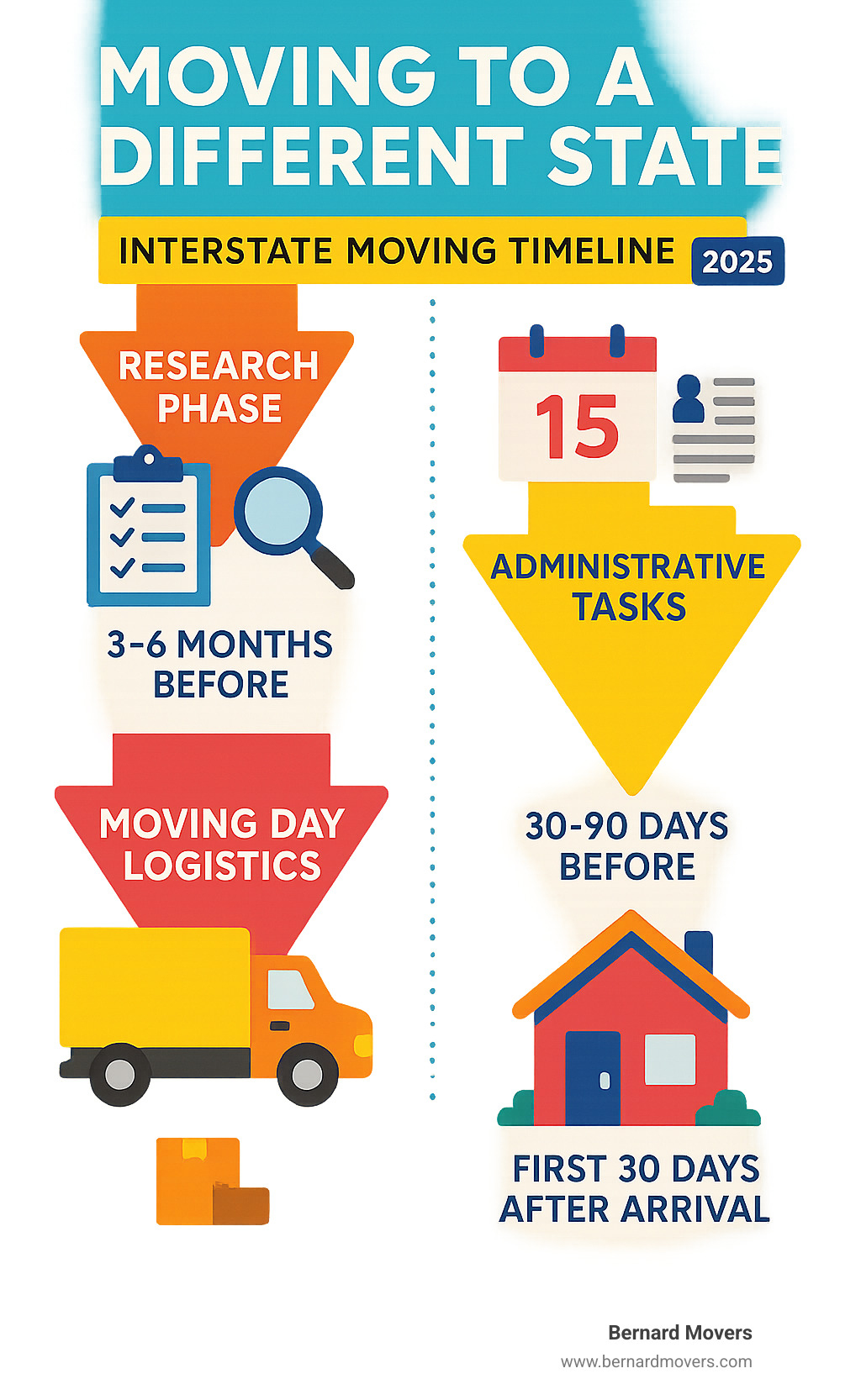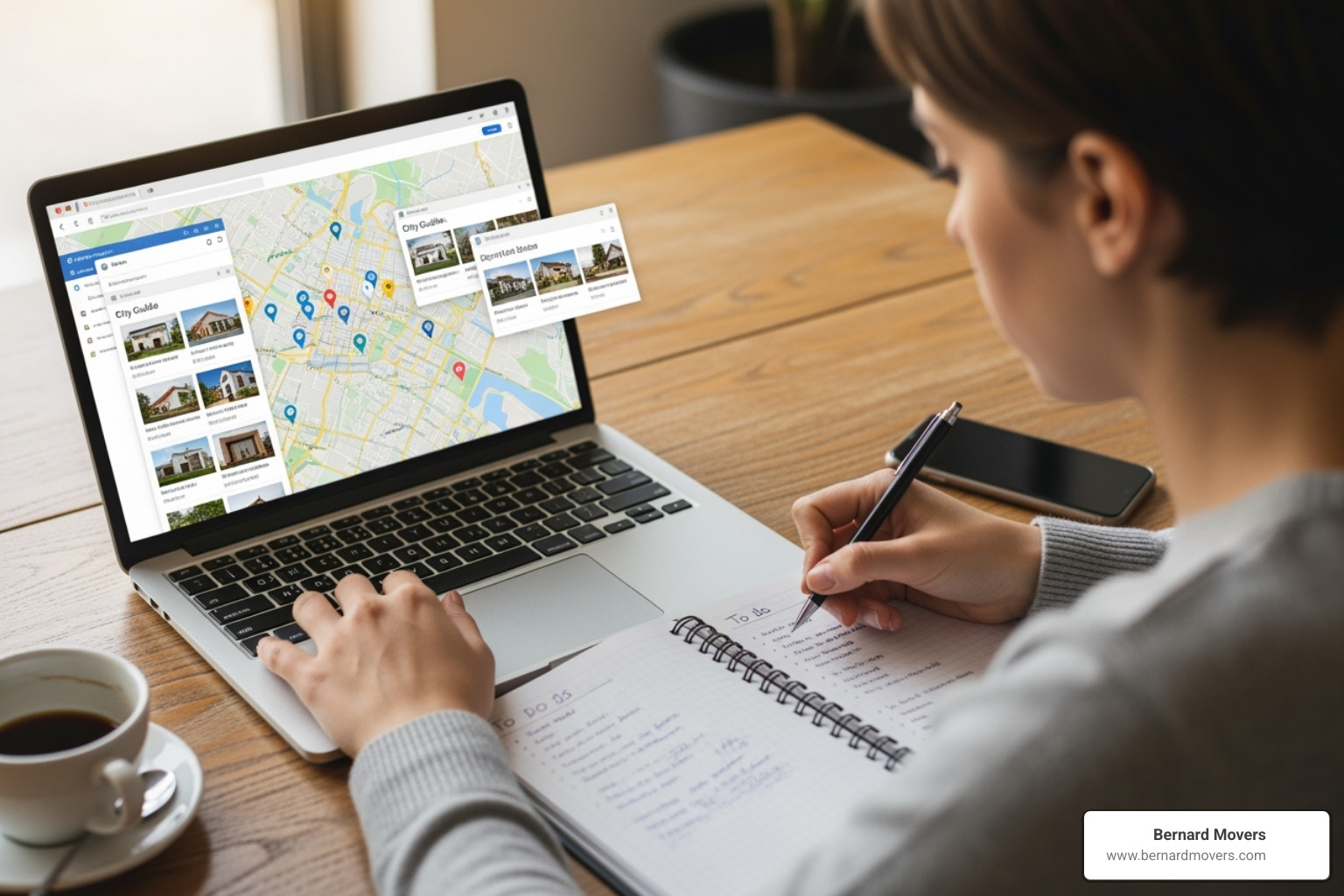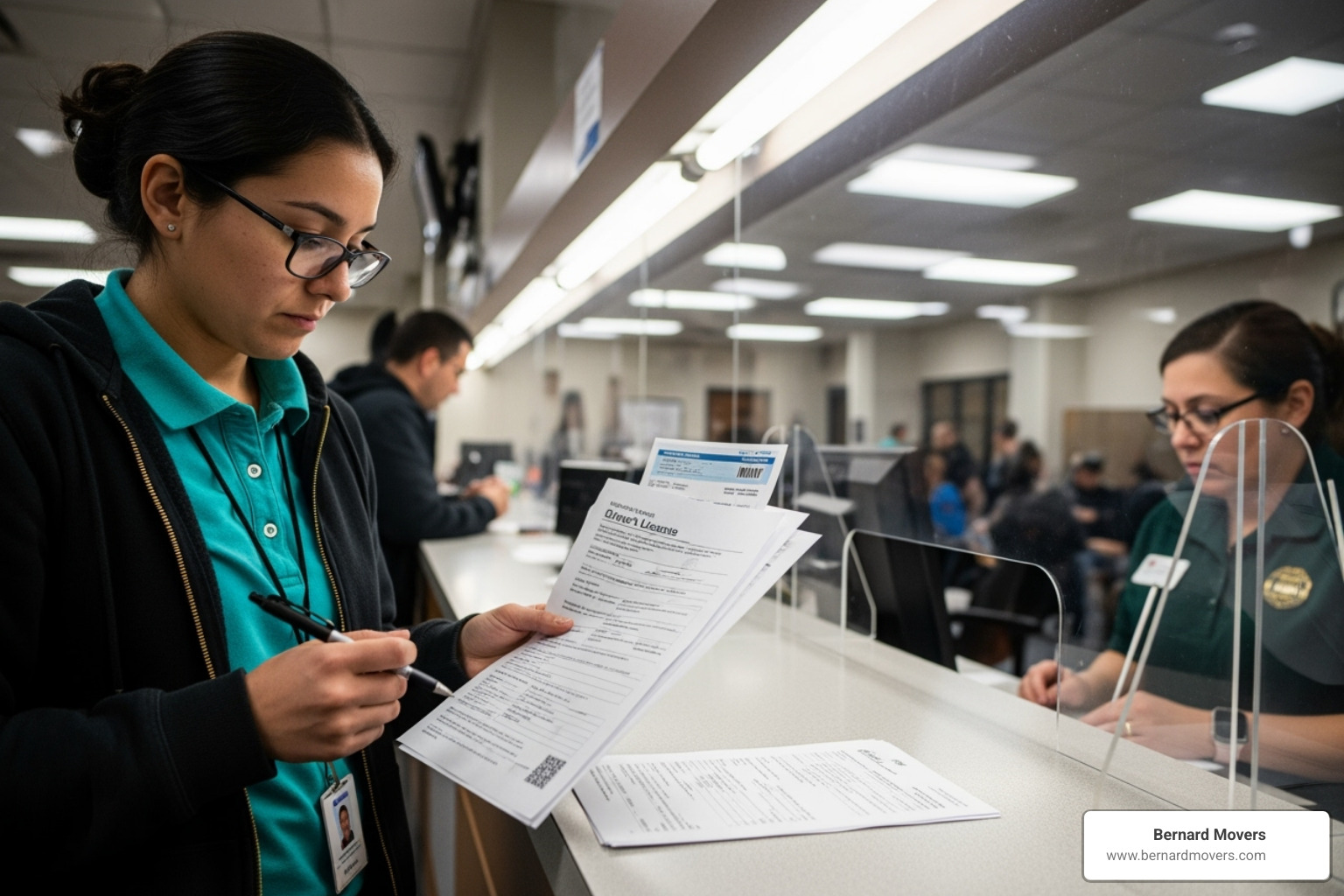If I move to a different state: Smooth 3-Month Guide
Why Moving to a Different State Requires Careful Planning
If I move to a different state, you’ll need to handle several key requirements within specific timeframes. Here’s what you need to know:
Essential Requirements When Moving States:
- Driver’s License: Must be updated within 30-90 days in most states
- Vehicle Registration: Required immediately upon establishing residency
- Voter Registration: Update through Vote.gov or local DMV
- Address Changes: File with USPS and notify banks, insurance, employers
- Professional Licenses: Transfer requirements vary by state and profession
- Tax Obligations: May need to file in multiple states during transition year
Moving to another state is an exciting, yet complex, undertaking. It’s more than just packing boxes; it involves researching job markets and housing costs, navigating the administrative maze of legal documents, and understanding new tax laws.
The good news? With a clear plan, your interstate move can be a smooth, stress-free success. The key is knowing what to expect and when to act.
As Mina Georgalas, owner and president of Bernard Movers with nearly 30 years of experience in the moving industry, I’ve helped thousands of families steer the complexities of interstate relocations. Through my experience guiding clients through moves across 45 states, I understand exactly what happens if I move to a different state and the critical steps needed for success.

If i move to a different state basics:
- cost to relocate to another state
- moving companies that pack and move out of state
- moving out of state checklist
Phase 1: Essential Research and Decision-Making

Before packing a single box, the most crucial step is thorough research. This isn’t just about finding a new address; it’s about finding a new community and a life that fits your needs. This groundwork is essential for success if I move to a different state.
Why Should I Consider Moving to a Different State?
People choose to move across state lines for many reasons. We often see clients seeking:
- Job Opportunities: Your desired career path may be more accessible in another state with a more robust economy for your field.
- Better Quality of Life: This can mean better schools, safer neighborhoods, or more access to nature and outdoor activities.
- Lower Cost of Living: A significant driver for many. According to a Homebay survey, 23% of movers relocate to save money. The most affordable states are often in the Midwest and South.
- Proximity to Family or Friends: Moving to be closer to loved ones is a common motivation.
- Climate Change: A desire for a different climate, whether warmer or colder, can prompt a move.
- Better Education: For families, the quality of schools is a primary concern.
- A Fresh Start: Sometimes, a change of scenery is needed for personal growth or to escape a negative environment.
The decision to move is deeply personal, driven by a desire for a better life. More info about moving tips
What Research is Critical Before Choosing a New State?
Once you know your “why,” it’s time for the “where.” Gather as much information as possible to ensure your chosen destination aligns with your goals.
- Job Market Analysis: Investigate industries, average pay, and demand for your specific field. The U.S. Bureau of Labor Statistics is an invaluable resource. It’s best to have a job lined up before moving.
- Cost of Living Comparison: Use online cost-of-living calculators to compare expenses like groceries, housing, and taxes. State taxes vary significantly and can impact your take-home pay.
- Housing Market Trends: Understand average rent and home prices, and whether it’s a buyer’s or seller’s market.
- School Ratings: For families, this is a top priority. Use sites like Niche and Great Schools to check ratings.
- Healthcare Quality: Research local hospitals and specialists, and confirm your insurance will be accepted.
- Crime Rates: Check local crime statistics for neighborhood safety. The Federal Bureau of Investigation Crime Data Explorer is a useful tool.
- Local Culture and Politics: Consider if the community’s values and lifestyle align with your own to ensure you’ll feel at home.
How Can I Get to Know a New Area from Afar?
If an in-person visit isn’t possible, use these tools to get a feel for your potential new home:
- Virtual Tours: Many real estate listings offer virtual tours of homes.
- Google Maps Street View: “Walk” the streets to see local businesses and get a feel for the neighborhood’s vibe.
- Online Forums and Social Media Groups: Local Reddit and Facebook groups offer unfiltered insights from residents.
- Neighborhood Review Sites: Websites like Walk Score provide data on walkability and transit access.
- Planning a Short Visit: If possible, a weekend trip is incredibly insightful. Mimic your daily routine to gauge the area’s true personality.
- Connecting with a Local Real Estate Agent: An experienced agent can provide valuable local knowledge and referrals.
Phase 2: Budgeting and Logistics for Your Interstate Move

Now that you’ve picked your new state, it’s time to focus on the budget. Proper financial planning is essential for a stress-free start. If I move to a different state, a well-thought-out budget prevents financial strain and ensures your new beginning isn’t burdened by debt. More info about a moving out of state budget
How Should I Budget for an Out-of-State Relocation?
Moving out of state can be costly. The average cost of hiring professional movers for a long-distance move is around $4,300 to $4,890. Your budget should cover the move itself, settling-in costs, and ongoing expenses.
Start by getting at least two to three written quotes from reputable, licensed, and insured moving companies. More info about getting a moving estimate
Don’t forget to budget for:
- Travel expenses: Gas, food, and lodging if driving, or flights and car shipping if flying.
- Temporary housing: An Airbnb or extended-stay hotel might be needed while you search for a permanent home.
- Deposits and fees: This includes security deposits for rentals and setup fees for utilities like electricity, water, and internet.
Here’s the golden rule: save enough to cover three to six months of living expenses in your new state, plus all moving costs. This emergency fund is crucial. Always add 10-15% to your estimated budget for unexpected costs.
What Are My Moving Options and How Do They Compare?
The “how” of moving your belongings is a big decision that impacts both your wallet and your sanity. Here are the professional services that can help:
Full-Service Professional Movers: This is the easiest way to move to another state. A professional team handles everything – packing, loading, transport, and insurance. While it’s an investment, it provides complete peace of mind.
Partial Packing Services: This option offers a middle ground. You can have professionals handle fragile or specialty items while you pack the rest, allowing you to save money while still getting expert help where it counts.
Storage Solutions: If your new home isn’t ready, or you need time to house hunt, secure storage facilities are essential. This service can bridge the gap seamlessly, keeping your belongings safe until you’re ready for them.
The right choice depends on your budget, timeline, and how much convenience you value. An Essential Guide to Out-of-State Moving Options
How Can I Save Money and Reduce Stress Before Moving Day?
With smart planning, you can reduce both the financial burden and the stress of moving.
Decluttering is my number one tip. Less stuff means lower moving costs and less to unpack. Sell or donate anything you no longer need or use.
Selling unwanted items on platforms like Facebook Marketplace can help offset moving costs. Donating goods is another great option, and many charities offer pickup services.
Creating a moving inventory helps you keep track of your belongings. Packing strategically by starting early with non-essentials and labeling boxes clearly will save you headaches later.
Items not worth moving: Consider leaving behind old appliances, outdated furniture without sentimental value, and clothes you no longer wear. Ask yourself if an item is useful, cost-efficient to move, and has sentimental value. If not, it’s probably best left behind.
More info about packing, loading, and storage
What to Do Before and During the Move if I Move to a Different State

After the planning comes the paperwork. While not the most exciting part, handling these administrative tasks correctly is essential. If I move to a different state, properly managing these legal requirements will save you from future headaches, fines, and legal trouble.
How do I officially move to another state and handle the paperwork?
Establishing domicile, or legal residency, is your first official step. This involves proving to your new state that you intend to make it your permanent home.
- Driver’s License: This is a top priority. Most states require you to get a new one within 30 to 90 days. Check your new state’s DMV website for its specific timeline and required documents to avoid multiple trips. Find your local DMV office to get started.
- Vehicle Registration: You’ll need to re-register your vehicle and get new license plates. Your car may also need to pass a state-specific inspection. You must have car insurance in your new state before you can register your vehicle.
- Voter Registration: Update your registration to vote in local and national elections. You can typically do this online or at the DMV. Check deadlines at Vote.gov.
- Change of Address: File a change of address with the USPS Movers Guide to forward your mail. Also, directly notify the IRS, banks, credit card companies, and your employer.
- Professional Licenses: Research transfer requirements for any professional licenses you hold. Policies vary by state and profession, so plan ahead to avoid employment gaps.
What Tax Implications Should I Be Aware Of?
Understanding the tax implications of your move can save you money and prevent issues with the IRS. If I move to a different state, be aware of the following:
- Filing in Two States: You will likely need to file part-year resident tax returns in both your old and new states for the year you move.
- State Income Tax: Tax rates vary significantly. Moving from a high-tax state to one with no state income tax can greatly impact your finances.
- Domicile vs. Residency: States have different rules for determining tax residency. High-tax states often audit former residents, so it’s important to clearly establish domicile in your new state.
I strongly recommend consulting a tax professional who specializes in interstate moves. Resources like Turbo Tax State Tax Tips can also be helpful. Keep meticulous records of your move to prove residency if needed.
What are the first steps if I move to a different state with my family?
Moving with family adds extra layers of planning.
- School Records: Coordinate with your children’s old and new schools to transfer records and complete enrollment.
- Child Custody: If I move to a different state and share custody, you typically need permission from the other parent and court approval. Consult an attorney, as laws vary by state. Custodial Relocation offers more information.
- Pet Relocation: Research your new state’s rules for animals, including required health certificates and vaccinations. The USDA pet travel rules website is an essential resource.
- Medical Records: Arrange to have medical records for all family members transferred. Stock up on essential prescriptions to cover the transition period while you find new providers.
Phase 3: Settling In and Making Your New State Home

Congratulations, you’ve arrived! The moving truck is gone, and you’re surrounded by boxes. This final phase is about turning your new house into a home and building the life you envisioned when you first wondered, “If I move to a different state, will I be happier?”
How well you settle in during these first few weeks is crucial. It’s normal to feel a mix of excitement and overwhelm. You’ve accomplished something huge, and now it’s time to make it yours.
What Are the First Things to Do After I Arrive?
Your first few days set the tone. Focus on these priorities:
- Unpack Survival Essentials: Start with a pre-packed suitcase containing toiletries, medications, clothes, and important documents. In the house, prioritize kitchen basics, bedding, and bathroom necessities.
- Set Up Utilities: Ensure electricity, gas, water, and internet are activated upon your arrival.
- Change the Locks: For security, change the locks on all exterior doors immediately.
- Explore Your Neighborhood: Take a walk or drive to find the nearest grocery store, parks, and other local spots. This helps you feel more connected.
- Meet Your Neighbors: A simple introduction can lead to a valuable support system and new friendships. More info about our residential moving services
How Can I Find New Healthcare Providers?
Finding new doctors and dentists is a crucial task to handle early.
- Ask for Recommendations: Get referrals from new coworkers, neighbors, or even your previous doctors.
- Check Your Insurance Network: Use your insurance provider’s website to find in-network doctors and specialists to avoid unexpected costs.
- Use Online Doctor Finders: The American Medical Association and Medicare.gov offer tools to locate physicians.
- Schedule Initial Appointments: Establish care with a primary physician and dentist before you need them, as new patient appointments can take time to schedule.
- Transfer Prescriptions: Move your prescriptions to a local pharmacy to avoid any gaps in medication.
How Can I Successfully Transition and Build a New Community?
Building a new social circle as an adult requires intentional effort. Here are effective ways to meet people and build your new network:
- Join Local Groups: Find a book club, hiking group, or sports league that matches your interests.
- Use Neighborhood Apps: Apps like Nextdoor can connect you with people and events in your immediate area.
- Volunteer: Contribute to your new community while meeting people who share your values.
- Attend Community Events: Go to farmers markets, local festivals, or library programs to meet locals.
- Take a Class: A cooking, fitness, or art class provides structured social interaction.
Be patient with yourself; it can take several months to a year to feel truly at home. It’s also normal to experience “relocation depression.” If you feel persistently sad or lonely, consider seeking support from a mental health professional. More info about mental fatigue after a move. And don’t forget to stay in touch with old friends—they can be a great source of support during your transition.
Frequently Asked Questions About Moving to a New State
Moving to a new state brings up many questions. After nearly 30 years in the moving industry, I’ve heard them all. Here are answers to the most common concerns.
How much money should I save before moving to another state?
If I move to a different state, financial preparedness is key. As a rule of thumb, save enough to cover three to six months of living expenses in your new state, in addition to your moving costs. The average professional interstate move costs between $4,300 and $4,890. Your savings should also account for security deposits, utility setup fees, and a 10-15% buffer for unexpected expenses. This financial cushion is especially crucial if you don’t have a job lined up.
How early should I start planning an out-of-state move?
Time is your best friend. The ideal timeline is 3-6 months before your move. This allows ample time for research, securing housing, and booking quality movers without feeling rushed. The minimum timeline I recommend is 8 weeks. Start with a detailed moving checklist to stay organized. Be sure to book your moving company 2-3 months in advance, especially if moving during peak season (summer and weekends), when the best movers get booked quickly.
A complete moving out of state checklist can help you stay on track.
What is the most cost-effective way to move between states?
The cheapest option isn’t always the best. To move cost-effectively, you need to balance price with reliability and peace of mind.
- Book during the off-season: Moving in the fall or winter can significantly lower your costs.
- Declutter: The less you move, the less you pay. Sell or donate items you no longer need.
- Be flexible with dates: Avoiding peak moving times like weekends and the end of the month can result in better rates.
Here’s some exciting news: Bernard Movers is currently offering a 20% additional discount on moves to Georgia and Florida booked for delivery by March 15, 2025. This is a fantastic opportunity to save while working with experienced professionals who can make your move a success.
Your Smooth Move to a New State Starts Here
Moving to a new state is a major undertaking, but breaking it down into manageable phases makes it achievable. From research and budgeting to handling paperwork and building a new community, each step brings you closer to your fresh start.
This is more than a relocation; it’s the beginning of a new chapter. The challenges of administrative tasks are temporary, while the rewards—new opportunities, friendships, and experiences—are long-lasting.
At Bernard Movers, we’ve been helping families steer these life-changing moves for nearly three decades. We understand that behind every box is a story of someone chasing their dreams. Our professional moving services are designed to handle the heavy lifting so you can focus on what really matters: settling into your new home.
Whether you’re relocating for a dream job or simply ready for a change, we’re here to make your interstate move as smooth as possible. We’re currently offering a 20% additional discount on moves to Georgia and Florida booked for delivery by March 15, 2025. It’s our way of helping you save on this important investment in your future.
Ready to take the next step? Get an instant quote for your out of state moving needs and let’s start planning your smooth transition to your new home state.